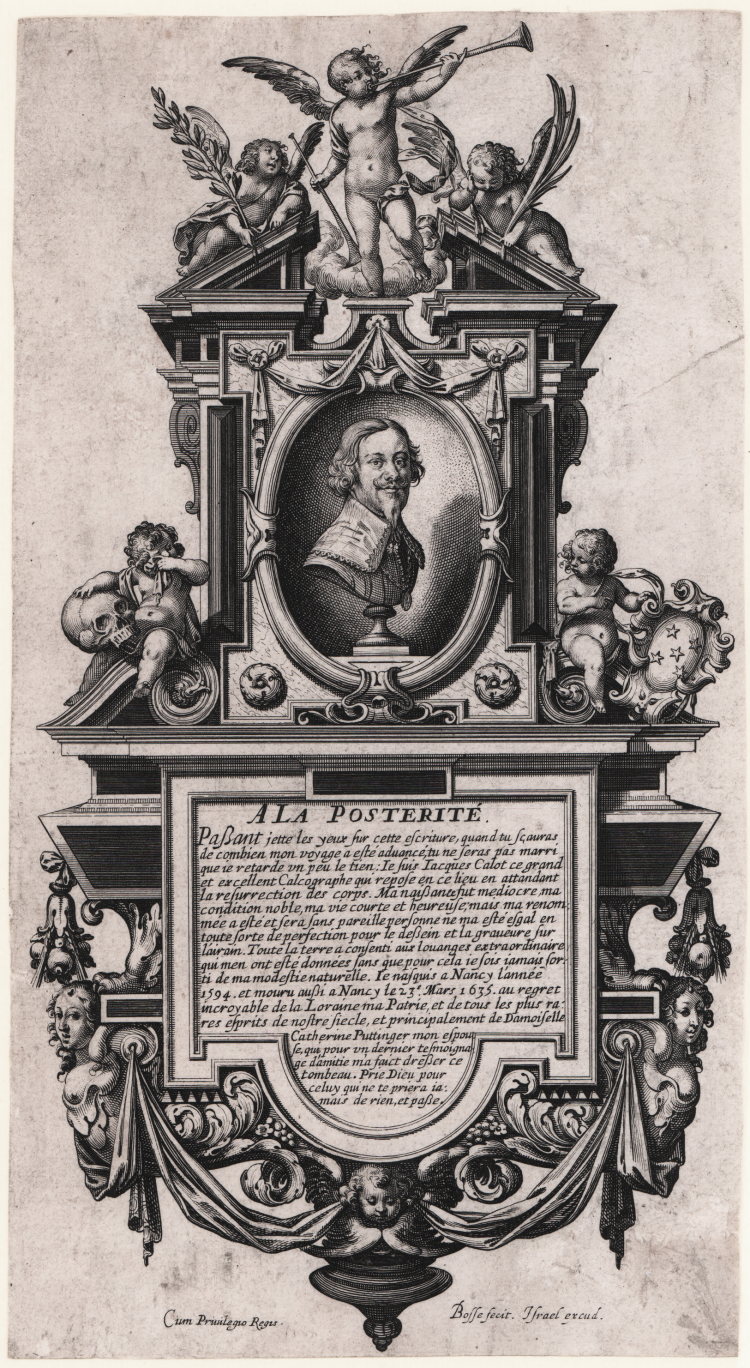




| Reference: | S17078 |
| Author | Abraham Bosse |
| Year: | 1636 |
| Measures: | 134 x 245 mm |



| Reference: | S17078 |
| Author | Abraham Bosse |
| Year: | 1636 |
| Measures: | 134 x 245 mm |
Monument for Jacques Callot, with a bust of the artist in an oval niche flanked by, on the left a putto holding a skull and, on the right, a putto and a coat of arms; surmounted by pedimental structure at the top of which are three winged Spirit, with one blowing a trumpet; in the lower part, engraved text in an cartouche.
Etching and engraving, 1636. signed and dated on lower part.
Magnificent work, rich in shades, printed on contemporary laid paper without watermark, trimmed inside the platemark but with the entire engraved part, minor repairs on the upper part, otherwise in good condition.
This plate has been realized one year after the death of Callot; the post-mortem portrait has been very likely commissioned by Israel Henriet, the publisher. The face of Callot recalls the portrait of Michel Lasne, realized in 1629. A very rare work.
|
Abraham Bosse savant graveur, p. 172, 142; Blum 1924 1013.III; Duplessis 1859 1234.III; Lothe 2008 146-III.
|
Abraham Bosse (Tours 1604 circa – Parigi 1676)
|
Abraham Bosse was a French artist, mainly as a printmaker in etching, but also in watercolour. Roughly 1500 etchings are attributed to him, and give fascinating and informative detail about middle and upper-class daily life in the period. In 1641 he began to attend classes given by the architect Girard Desargues (1591–1661) on perspective and other technical aspects of depiction. Bosse not only adopted these methods but also published a series of works between 1643–1653 explaining and promoting them. In 1648, when Cardinal Mazarin established the Académie royale de peinture et de sculpture, Bosse was made a founding member. However his publicising of Desargues' methods embroiled him in a controversy with Charles Le Brun and his followers who had different methods, and also a belief that "genius" rather than technical method should be the guide in creating artworks. In 1661 Bosse was forced to withdraw from the Academy; he established his own school as an alternative.
|
|
Abraham Bosse savant graveur, p. 172, 142; Blum 1924 1013.III; Duplessis 1859 1234.III; Lothe 2008 146-III.
|
Abraham Bosse (Tours 1604 circa – Parigi 1676)
|
Abraham Bosse was a French artist, mainly as a printmaker in etching, but also in watercolour. Roughly 1500 etchings are attributed to him, and give fascinating and informative detail about middle and upper-class daily life in the period. In 1641 he began to attend classes given by the architect Girard Desargues (1591–1661) on perspective and other technical aspects of depiction. Bosse not only adopted these methods but also published a series of works between 1643–1653 explaining and promoting them. In 1648, when Cardinal Mazarin established the Académie royale de peinture et de sculpture, Bosse was made a founding member. However his publicising of Desargues' methods embroiled him in a controversy with Charles Le Brun and his followers who had different methods, and also a belief that "genius" rather than technical method should be the guide in creating artworks. In 1661 Bosse was forced to withdraw from the Academy; he established his own school as an alternative.
|